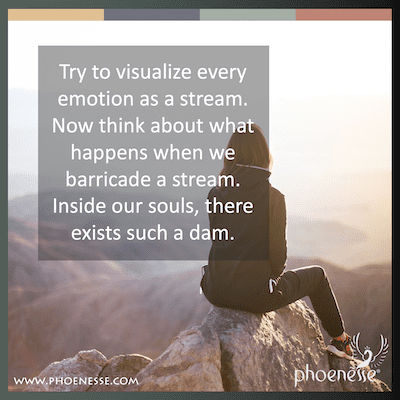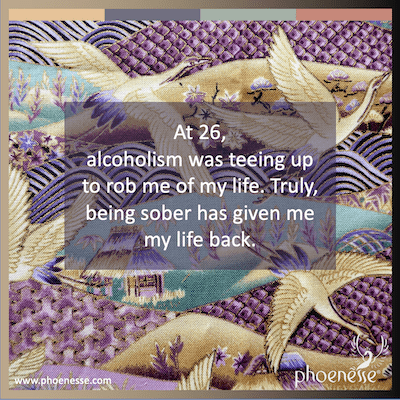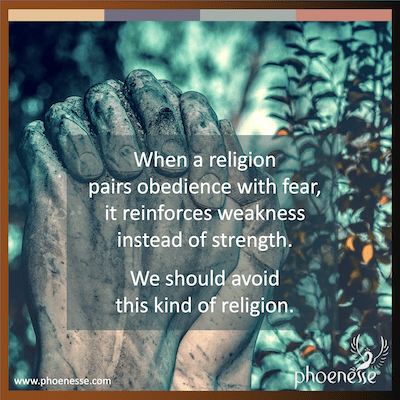
So many of us experience life as a confusing, puzzling ordeal. It’s difficult, we say, and painful. It’s a struggle, and there seems to be no meaning to life. It’s like we feel we’re separate from life. But friends, this is so not true!
The way our life appears on the outside right now is an exact replica of how we experience ourselves on the inside. It’s a giant conglomeration of all our attitudes and inner traits, showing up as this thing we call “my life”.
Which means it’s a huge error—one of the biggest errors there is—to believe that we are one thing and the life we have been put into is another. It simply is not so.
Struggle: Healthy and unhealthy
Life can be a real struggle. What’s important to realize is that our struggle can either be healthy and constructive, or it can be unhealthy and therefore destructive.
Perhaps we’re familiar with some religion or philosophy that tells we need to “give up the struggle.” While such a teaching may be true, we too often misunderstand this to mean we should give up, or give in. That we should become passive and not stand up for ourselves. That we should let go of our goals and our desire for fulfillment.
Such an approach takes us down a wrong road to becoming a sloth. It leads to indifference and stagnation, and even makes us beat ourselves up for wanting more from life.
Worse yet, such an attitude causes us to not improve the conditions in our life—in ourselves and in the world around us—that we have the ability to make better. And in a way, that’s downright cruel.
A healthy struggle, by contrast, doesn’t wear us out. For when we take a healthy approach to our struggles, our efforts are not futile and our energies don’t become exhausted. When we struggle in the right way, we stop fighting against ourselves.
The wrong way to struggle
When we struggle against the stream in an unhealthy way, we are consumed by the struggle. The struggle wipes us out. Healthy struggle, on the other hand, actually makes us stronger.
After all, it doesn’t take any effort at all to allow whatever is inside us to bubble to the surface. In fact, we tend to waste a lot of energy to keep inner material from coming to the surface. And then we wonder why we feel so tired all the time.
We reach the point where we feel we just don’t have the energy to cope with life. But if we were to turn things around—to start struggling the right way—life would be very different. For we are fighting with all our might to not become aware of whatever is inside us, right now. We do this by constantly blocking the flow of our feelings, which is exhausting.
And this, folks, is the very meaning of the unhealthy struggle.
Obstructing the stream
We can compare our feelings—and the attitudes that go along with them—to streams. As these streams of emotions move, they go through cycles in which they are affected by inside and outside influences. But what is really controlling them lies inside us.
We then we try to shift the control of our feelings to something outside us—say, outer circumstances—hoping that the damage can be repaired from the outside. We go through life expecting help to come along and adjust the disharmonious flow of our feelings. When we do this, we prevent the free flow that could bring awareness of what we’re really feeling.
By putting our focus outside ourselves, we separate more and more from the real control we have at our fingertips. And in the end, having complete awareness of the self is the only meaningful control there is.
Let’s keep going with this analogy of a stream and, using this approach, let’s look at the damage we are doing when we repress our feelings. For by seeing things this way, we might become inspired to remove these barricades.
The real cause of a crisis
Try to visualize every emotion—every attitude and response we have about life—as a stream. Now think about what happens when we barricade a stream. After all, it’s entirely possible to dam up a river. In such a case, water that is flowing towards the dam is going to be stopped.
The more water accumulates behind the dam, the greater the energy becomes of the water that is being backed up. Until one day the water bursts the dam, overflowing it and destroying not only the dam, but also all the healthy and natural vegetation and structures along the way.
But it’s not necessary to destroy the barricade in such a violent way.
Inside our souls, there exists such a dam. And it never needed to have been built. But since we have each chosen to erect such an obstruction, now it has to go. It could be possible to remove this inner dam in a gradual and systematic way, by our own efforts. We might call such a conscious process self-confrontation.
Or we can wait and let nature take its course. In that case, the barricade is going to come down when it is swept away by the force of the backed-up waters. When life handles us roughly like this—when our accumulated destructive attitudes keep pushing against this barricade until it finally breaks loose—we have what we call a crisis.
Clearing the debris
If we opt to not dam up the river, we let the debris freely float to the surface so it can be eliminated. For flowing water, which is pure and fresh and constantly regenerating, will sweep the river free of debris. Isn’t that just the way nature works?
It works the same way with our soul currents.
It’s only when we fear them and keep looking away from the debris of our past hurts—along with the destructive tendencies they spawn—that they accumulate behind a barricade. And as a result, they are bound to swamp us one day when we find we can’t control what happens.
But letting the debris come to the surface is not something we need to fear. That said, when we begin to remove our inner blocks, we are going to experience negative emotions that are unlike anything we’ve felt before. And so it will be tempting to slam the lid back on.
Be aware of this temptation.
For behind these negative feelings lie all our positive, generous, loving and unselfish feelings. And they will follow once the negative feelings are allowed to flow and no longer feel so detrimental to us. Keep in mind, by not feeling those darker feelings, they don’t magically go away.
Swamped by insecurity
For example, when we struggle against feeling insecure—denying that our insecurity exists— insecurity rises up behind the dam. The water swells. As long as the dam keeps holding, what we’ll feel is a vague discomfort. We will feel inhibited, but we won’t understand why. We’ll feel that some of our best potentials are being underutilized.
We won’t have a full grasp of what’s happening, but our feelings of insecurity will keep getting stronger, building up behind the dam. We won’t feel the full force of our insecurity until the day comes when some outer event will swamp us. And then we’ll feel all the despair of the insecurity and helplessness we hadn’t dared to face.
So when we’re struggling to keep our insecurity at bay, we are actually making it bigger. Denying its existence increases it and makes it stronger than it would have been otherwise. It works the same way with other emotions like fear, doubt and hostility. Because the underlying principle is always the same.
Wouldn’t it be smarter to just go ahead and remove the barricade? Why keep waiting until nature finally breaks it down and causes us to feel helpless? For when that happens, our feelings swamp us, but we don’t understand their meaning. Because the accumulated momentum just becomes too strong.
We don’t need to wait until such times.
Facing into our resistance
If there is one aim in following this spiritual path of Phoenesse and the Pathwork Guide it is this: to avoid the unnecessary struggle. When we follow this path, we work to remove our inner barricades before they remove themselves. We allow our feelings to flow, and in doing so, we bring out whatever they are holding.
By facing the feelings we would rather avoid, escape and deny—including our doubts and aggression, jealousy and possessiveness, self-importance and self-centeredness—we are facing everything that belongs to the hurt child still living inside us.
What makes us want to run away from these emotions?
It has to do with defending ourselves against exposure, vulnerability and hurt. But that’s not the whole story.
Why do we resist?
It is not enough to say that our inner barricade—our defense against feeling our feelings—defends us against the hurts in life. Here’s what’s really going on: We maintain our resistance to feeling our feelings because we are hoping we can remain a child.
Children, after all, seem to have the advantage of being given everything they need to be secure and happy. And they don’t have to get it for themselves.
This is such a tempting illusion, that we could be entitled to receive without the need to stand on our own two feet. We recall this advantage of childhood and combine it with our fear of dipping into the barricade where our past hurts are buried.
On top of this, our unwillingness to face this buried pain has built up a deliberate helplessness. Our ego has stayed weak, so now it can’t trust itself. This creates an excuse for us to depend on others for our needs.
We don’t want to give up on the belief that our happiness, our fulfillment and our security can come from outside us. In fact, we cling to this hope.
This is the fundamental reason we resist removing the barrier.
Gaining emotional maturity
To have emotional maturity is to have the ability to tolerate frustration. We need to accept that everything isn’t going to always go our way. Then we will float with the wave and stop stemming against it. Oddly enough, doing this is what will give us self-confidence.
By gaining the ability to accept not having whatever we want, we gain trust in ourselves. If we insist on having what we want without being able to get it for ourselves, then we are going to remain insecure, helpless and dependent. But by accepting frustration, we will have the confidence to know that we can cope with life.
Think deeply about these last two sentences, friends.
Disentangling countercurrents
Both a child and a sick person are basically helpless, needing to depend on others. So a resisting psyche is not only a child that hasn’t grown up yet, but it’s deliberately being an invalid.
On one hand, we’re afraid of being helpless and don’t really even know if our helplessness is real. On the other hand, we’re afraid to admit that we might have more inner resources than we care to admit. Because admitting we have these untapped resources might create certain obligations, like assuming responsibility for ourselves.
These are the kind of countercurrents we must find and free up: our fear of being helpless and, at the same time, our fear of knowing we don’t need to be helpless if we don’t want to be. Plus, we fear having to give up our childish desire for instant gratification.
Our resistance to seeing these things inside us cuts us off from the stream of life. The longer we do this, the more water builds up behind the barricade. The way out is by starting to notice how we are always trying to shove unpleasant feelings aside.
Our hope is that they will just go away.
The Gateway Prayer
Through the gateway of feeling your weakness lies your strength;
Through the gateway of feeling your pain lies your pleasure and joy;
Through the gateway of feeling your fear lies your security and safety;
Through the gateway of feeling your loneliness lies your capacity to have
fulfillment, love and companionship;
Through the gateway of feeling your hate lies your capacity to love;
Through the gateway of feeling your hopelessness lies true and justified hope;
Through the gateway of accepting the lacks of your childhood
lies your fulfillment now.
– Pathwork® Guide Lecture #190: Importance of Experiencing All Feelings, Including Fear
Facing our fear
Fear is a universal feeling that everyone must learn to grapple with. It’s an error to believe that becoming aware of our fear will cause it to overflow. For awareness is not the cause of our difficulty. The bigger problem is our attitude toward our fear and whatever lies beneath it.
When we are in an unhealthy struggle, we tell ourselves, “I should not be afraid. Fear is unpleasant, so I don’t want to feel it.” With such a sentiment, we are fighting against the part of us that happens to be in fear right now. By bracing against the wave of fear, we create the fear of being flooded by fear.
The problem is that we are still defending ourselves against looking at our fear. But we can stop struggling so hard against the fear. We can say, “I am a human, and like so many others I am now feeling fear.”
Such an approach will let us float on the wave of fear, rather than be swamped by it. We will find we can swim in fear, and not drown in it. Fear, then, won’t feel so dangerous. It will still be there, but it won’t feel as bad.
What’s behind our fear?
When we struggle against a wave of fear, we become immersed in it. For it’s our fear of drowning that prevents us from swimming, even when we have the capacity to swim. And it’s only when we are swimming that we can see what’s behind our fear.
The fear we are talking about is a nagging and persistent fear, which is unrealistic fear. Underneath this fear—the fear we are so reluctant to face—we will always find other “streams of feelings” that are blocked and unable to flow.
They could be made up of things like hostility, hurt and humiliation, shame, pride and arrogance, self-pity, self-importance and an insistence on unreasonable demands. These are what we are really struggling against when we are struggling to avoid our fear. But if we allow them to come out into the fresh air of our conscious awareness, the fear will automatically decrease and eventually disappear.
This is a promise.
The right way to struggle
We all struggled in some way as children. When we feel an inner discomfort, it’s likely we felt the same way as a child. It is these old childhood hurts that make us barricade the stream, put up resistance, and tell ourselves lies about what’s really going on.
We then live life in old destructive patterns, while fear and insecurity eat away at us.
As a result, we struggle in the wrong direction. And that’s why we feel we are not in harmony with the flow of life. That’s why we feel disconnected from life.
The only way out is to stop resisting, and turn and face ourselves. The way to the other side is by entering the stream. That’s the healthy struggle. We must let our difficult emotions float freely to the surface so we can discover we have nothing to fear from them.
Putting this into practice
We can begin by asking ourselves the following questions:
- If I want to start being honest with myself, what’s the most important place for me to look?
- What activities can help me do this the most?
- Am I deceiving myself by wishing that some activity other than self-development will bring me spiritual development?
- Is it possible to grow without facing myself?
- Am I doing enough, or could I be doing more?
- If I could be doing more, why am I resisting this?
- Am I only willing to cultivate self-discovery in the places that don’t create anxiety in me?
- Do I avoid the places in me that hurt?
- Why and where do I resist knowing what is in me?
- What is my attitude towards myself in admitting this?
- If I want to keep resisting, isn’t it better to at least know that I don’t have the courage to look at myself?
- Do I have the courage to admit this?
- Can I see that there are some areas in me that I am willing to look at truthfully, while in other areas the opposite is true?
Now listen carefully to your answers. Pray to hear the answers without deceiving yourself. Write them down. Doing this exercise with self-honesty means more than you can possibly imagine.
“You cannot do enough pondering over this lecture. Try to make it a lived knowledge; apply it to yourself personally, rather than merely understanding it intellectually. Receive our love and blessings. You have nothing to fear.”
–Pathwork Guide Lecture # 114: Struggle: Healthy and Unhealthy
The Pathwork Guide’s wisdom in Jill Loree’s words,

Adapted from Pathwork Guide Lecture # 114: Struggle: Healthy and Unhealthy
Learn more in Blinded by Fear: Insights from the Pathwork Guide on how to face our fears, and Bones, Chapter 2: The importance of feeling all our feelings, including fear | Listen to podcast
We can heal | AFTER THE EGO • BLINDED BY FEAR
The Real. Clear. series | HOLY MOLY • FINDING GOLD • BIBLE ME THIS • THE PULL • PEARLS • GEMS • BONES • NUTSHELLS
The Self. Care. series | SPILLING THE SCRIPT • HEALING THE HURT • DOING THE WORK
More spiritual books | WALKER (a memoir) • SPIRITUAL LAWS • WORD FOR WORD • KEYS (Pathwork Q&As)





